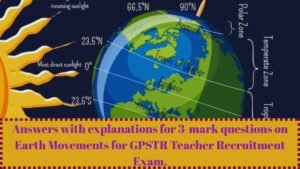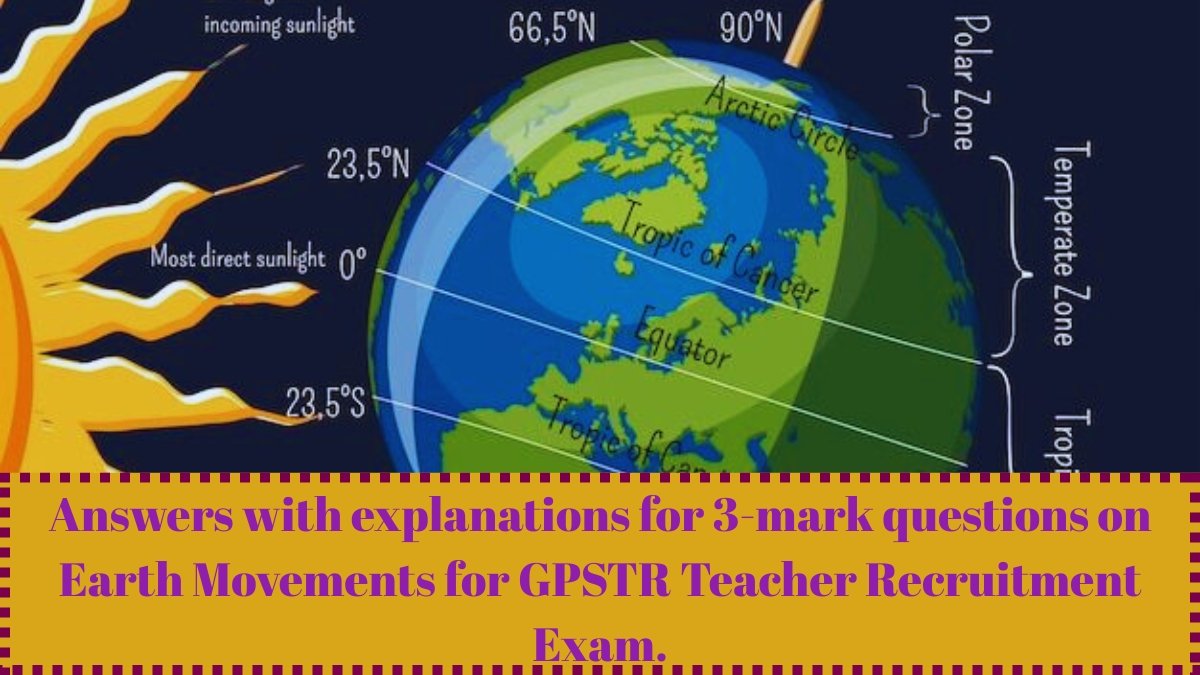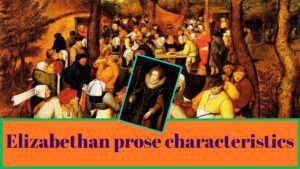Earth Movements:Answers with explanations for 3-mark questions on Earth Movements for GPSTR Teacher Recruitment Exam.

1. Eclipses occur due to which optical phenomena ?
1) Reflection
2) Refraction
3) Rectilinear Propagation
4) Difraction
Ans:- 3) Rectilinear Propagation
• Rectilinear propagation of light means that it travels in a straight line from the light source. The shadow formed when an object comes between two objects is called an eclipse.
• Example:- During a lunar eclipse, the Earth comes between the Sun and the Moon. Then a dark shadow of the Moon is formed. This phenomenon occurs only when the Moon moves in a straight line. This is called rectilinear propagation.
—————————————————————————-
2. The earth completes one rotation on its axis in:
1) 23 hrs. 56 min. 4.9 sec
2) 23 hrs. 10 min. 2 sec
3) 23 hrs. 30 min.
4) 24 hrs.
Ans:- 1) 23 hrs. 56 min. 4.9 sec
• The Earth actually takes 23 hours, 56 minutes and 4.09 seconds to rotate on its axis. This period is called a ‘sidereal day’. But the average period of the Earth’s daily motion with respect to the Sun is 24 hours. This is called a ‘solar day’.
—————————————————————————–
3. Uneven distribution of insolation on
1) spherical shape of the earth
2) distribution of land and water
3) direction of the winds
4) presence of pressure belts
Ans:- 1) spherical shape of the earth
• The uneven distribution of solar heat on Earth is mainly due to the Earth’s tilted axis and spherical shape.
• The amount of time the Earth’s surface is exposed to solar radiation varies throughout the year, depending on the season. Another factor that affects solar radiation on Earth is the Earth’s rotation. All of these factors lead to an uneven distribution of heat on Earth. This creates a heat gradient.
—————————————————————————
4. Why the Earth is having its own atmos phere?
1) Winds
2) Clouds
3) Gravity
4) Rotation of the Earth
Ans:- 3) Gravity
• Our Earth has an atmosphere due to gravity.
• Gravity causes gases to be held in the Earth’s atmosphere instead of escaping into space. In addition, gravity pulls the atmosphere closer to the Earth.
————————————————————————–
5. If speed of rotation of the earth increases, the weight of the body
1) decreases
2) increases
3) remains the same
4) may increase or decrease
Ans:- 1) decreases
• The weight of a body on Earth is the amount of gravitational force exerted by the Earth.
• Similarly, a centrifugal force is exerted on a body on Earth. It tends to move the body away from the center and at the Earth’s equator The speed of rotation is maximum at the equator, so it is maximum. The force of gravity is balanced by the centrifugal force.
• With an increase in the speed of Earth’s rotation, the body becomes more susceptible to the influence of centrifugal force at the equator and the weight of the body decreases.
• It is estimated that if the Earth rotated 17 times faster than it does now, the weight of a body at the equator would be zero.
————————————————————————
6. What is the position of the Earth when it is at the greatest distance from the sun?
1) Aphelion
2) Antipode
3) Perihelion
4) Aldiate
Ans:- 1) Aphelion
• The Earth appears closest to the Sun on January 3rd.
• This position of the Earth is called ‘Perihelion’. At this position, the distance between the Earth and the Sun is 147 million km.
• On July 4, the Earth is farthest from the Sun. This position of the Earth is called Aphelion. At this position, the distance between the Earth and the Sun is 152 million km.
—————————————————————————
7. What causes day and night cycle on Earth?
1) Rotation
2) Revolution
3) Rotation and Revolution both
4) None of these
Ans:- 1) Rotation
• The rotation of the Earth on its own orbit causes day and night. As the Earth rotates, the side of the Earth facing the Sun experiences daylight and the opposite side experiences darkness or night.
————————————————————————-
8. Which one of the following pair is INCORRECT with respect to Solstice and Equinox?
1) 21 March Equator
2) 21 June Tropic of Cancer
3) 22 December – Tropic of Capricorn
4) 23 September – North Pole
Ans:- 4) 23 September – North Pole
• There are two solstices (June 21 and December 22) and two equinoxes (September 23 and March 21) in the seasons.
• During the solstices, the sun’s rays fall directly on the Tropic of Cancer and Capricorn, and on the equatorial circle during the equinoxes.
• The ions influence the duration of day and night (in both hemispheres).
• Similarly, on the equinoxes (the solstices), there are equal days and nights (in both hemispheres).
——————————————————————————
9. On which of the following date, summer solstice is observed in Southern Hemisphere?
1) 22nd December
2) 5th August
3) 18th July
4) 11th January
Ans:- 1) 22nd December
• Winter (December 22 – March 20) On December 22, the direct rays of the sun fall on the Tropic of Capricorn (23¾° South latitude). This period is called ‘Makarayana’. During this period, winter begins in all countries in the Northern Hemisphere and continues till March 20. During this period, summer is observed in the Southern Hemisphere.
• During this time, the average temperature in the Northern Hemisphere is lower, and the days are shorter and the nights longer. The opposite situation occurs in the Southern Hemisphere.
—————————————————————————–
10. On which of the following date summer solstice is observed in Northern Hemisphere?
1) 21 June
2) 5th August
3) 18th July
4) 19th December
Ans:- 1) 21 June
• Summer season
• (June 21 to September 22) On June 21, the direct rays of the sun fall on the Tropic of Cancer (231¾° North latitude). This period is called ‘Katakayana’.
• During this period, summer begins in the Northern Hemisphere and continues until September 22.
• During this period, the average temperature increases in all countries in the Northern Hemisphere, with longer days and shorter nights. The opposite situation occurs in the Southern Hemisphere.
——————————————————————————

11. On which of the following date winter solstice is observed in Southern Hemisphere?
1) 5th August
2) 10th August
3) 15th February
4) 21th June
Ans:- 4) 21th June
• The winter solstice is an astronomical phenomenon that marks the shortest day and longest night of the year.
• In the Northern Hemisphere, it is the December 21st solstice.
• In the Southern Hemisphere, this is the June 21st solstice.
• The solstices are opposite on either side of the equator. So the winter solstice in the Northern Hemisphere is the summer solstice in the Southern Hemisphere.
—————————————————————————–
12. The amount of insolation received at a place on the surface of the earth depends upon:
1) its climate
2) the longitude of the place
3) its latitude
4) the altitude of the place
Ans:-3) its latitude
• Insolation is a measure of the solar radiation energy received at a specific altitude at a specific time.
This mainly depends on two factors:
• (a) The angle at which the sun’s rays reach the earth and
• (b) Duration of exposure to the rays. Both of these factors are controlled by latitude, location and time of year.
——————————————————————————-
13. Tides are caused by the gravitational pull of the
1) Earth on the Moon
2) Earth on the Sun
3) Sun and Moon on the Earth
4) Moon on the Earth
Ans:- 3) Sun and Moon on the Earth
• The rising and falling of sea water levels is called tides.
• Gravity is a major force that creates tides.
• In 1687, Sir Isaac Newton explained that ocean tides are caused by the gravitational pull of the Sun and Moon on the Earth’s oceans.
• This is a natural process that occurs continuously in the oceans due to the Earth’s daily motion and the Earth’s centrifugal force.
—————————————————————————
14. When the moon completely covers the sun, it is known as
1) The Antumbra
2) The Umbra
3) The Penumbra
4) None of these
Ans:- 2) The Umbra
• Total solar eclipse: When the sun, moon and earth come in a straight line on the day of Amavasya, the shadow of the moon falls on the earth. The sun is not completely visible on the part of the earth that is completely covered by this shadow. This is a total solar eclipse. The part of the total solar eclipse is called the Umbra.
—————————————————————————–
15. The darkest portion of the shadow cast during an eclipse is
1) Corona
2) The Umbra
3) Penumbra
4) Black hole
Ans:- 2) The Umbra
• Umbra (Latin for “shadow”) is the innermost and darkest part of the shadow.
• All planets and other celestial bodies cast a triangular shadow in the direction opposite the light source they receive. The darkest part of this shadow is the umbra, or shadow of the sun.
• The penumbra is the part of the light shadow.
————————————————————————–





